
Concept explainers
(a)
To find: The equation and
(a)
Answer to Problem 32E
The
Explanation of Solution
Given information:
The least squares regression line for a set of data. The equations and r-values for the models are given.
Formula used:
The TI83 calculator is used.
Calculation:
Consider the following equation
Use TI83 calculator to draw the graph of the equation
Step1: Press Y: button and enter the above equation
The display is as shown below
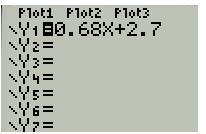
Step2: Press WINDOW button and set the range of the axis
The display is as shown below
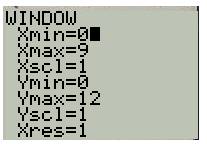
Step3: Press Graph button to graph the above sequence
The display is as shown below
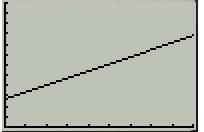
Note that the above graph is same as the graph provide in option (iii).
Therefore, the equation
Also, since the slope of the equation
Consider the following equation
Use TI83 calculator to draw the graph of the equation
Step1: Press Y: button and enter the above equation
The display is as shown below
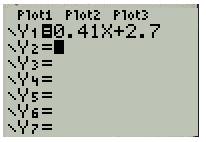
Step2: Press WINDOW button and set the range of the axis
The display is as shown below
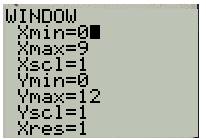
Step3: Press Graph button to graph the above sequence
The display is as shown below
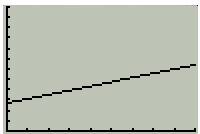
Note that the above graph is same as the graph provide in option (ii).
Therefore, the equation y = 0.41x + 2.7 represents the graph (ii)
Also, since the slope of the equation
Consider the following equation
Use T|83 calculator to draw the graph of the equation
Step1: Press Y: button and enter the above equation
The display is as shown below
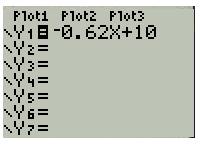
Step2: Press WINDOW button and set the range of the axis
The display is as shown below
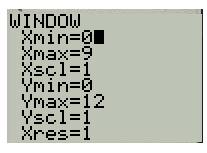
Step3: Press Graph button to graph the above sequence
The display is as shown below
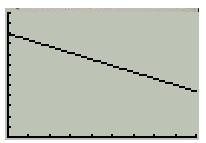
Note that the above graph is same as the graph provide in option (i).
Therefore, the equation
Also, since the slope of the equation
Conclusion:
The correlation coefficient that represents the graph.
(b)
To analyse: The model that best fits the data.
(b)
Answer to Problem 32E
The model number 3 fits the data well which represents
Explanation of Solution
Given information:
According to the correlation coefficients, to determine the best fit for the data.
Formula used:
Correlation coefficients are used.
Calculation:
According to the correlation coefficients, model number 3 fits the data well which represents
Conclusion:
The model number 3 fits the data well which represents
Chapter 1 Solutions
EP PRECALC.GRAPHING APPR.-WEBASSIGN-1YR
- Evaluate the next integralarrow_forward1. For each of the following, find the critical numbers of f, the intervals on which f is increasing or decreasing, and the relative maximum and minimum values of f. (a) f(x) = x² - 2x²+3 (b) f(x) = (x+1)5-5x-2 (c) f(x) = x2 x-9 2. For each of the following, find the intervals on which f is concave upward or downward and the inflection points of f. (a) f(x) = x - 2x²+3 (b) g(x) = x³- x (c) f(x)=x-6x3 + x-8 3. Find the relative maximum and minimum values of the following functions by using the Second Derivative Test. (a) f(x)=1+3x² - 2x3 (b) g(x) = 2x3 + 3x² - 12x-4arrow_forwardFind the Soultion to the following dy differential equation using Fourier in transforms: = , хуо, ухо according to the terms: lim u(x,y) = 0 x18 lim 4x (x,y) = 0 x14 2 u (x, 0) = =\u(o,y) = -y لوarrow_forward
- Can you solve question 3,4,5 and 6 for this questionarrow_forwardwater at a rate of 2 m³/min. of the water height in this tank? 16) A box with a square base and an open top must have a volume of 256 cubic inches. Find the dimensions of the box that will minimize the amount of material used (the surface area). 17) A farmer wishes toarrow_forward#14 Sand pours from a chute and forms a conical pile whose height is always equal to its base diameter. The height o the pile increases at a rate of 5 feet/hour. Find the rate of change of the volume of the sand in the conical pile when the height of the pile is 4 feet.arrow_forward
- (d)(65in(x)-5 cos(x) dx mins by 5x-2x² 3x+1 dx -dx 20 Evaluate each the following indefinite integralsarrow_forward19 Evaluate each the following definite integrals: a) લ b) (+3) 6) (2-2)(+33) dxarrow_forward#11 If a snowball melts so its surface area decreases at a rate of 1cm²/min, find the rate at which the diameter decreases when the diameter is 6 cm.arrow_forward
- Use Deritivitve of the inverse to solve thisarrow_forwardEvaluate the following Limits: e6x-1 Lim +0Sin3x 7x-5x2 2x-1+ Cos 4x +6 c) Lim b) Lim + x³-x2 X-0 1-e' 4x d) Lim 6x²-3 X+0 6x+2x² Find the derivatives of the following functions using the Limit definition of derivativearrow_forward15A cylindrical tank with radius 8 m is being filled with water at a rate of 2 m³/min. What is the rate of change of the water height in this tank? 6)A box with a square base and an open top must box that will minimiarrow_forward
 Calculus: Early TranscendentalsCalculusISBN:9781285741550Author:James StewartPublisher:Cengage Learning
Calculus: Early TranscendentalsCalculusISBN:9781285741550Author:James StewartPublisher:Cengage Learning Thomas' Calculus (14th Edition)CalculusISBN:9780134438986Author:Joel R. Hass, Christopher E. Heil, Maurice D. WeirPublisher:PEARSON
Thomas' Calculus (14th Edition)CalculusISBN:9780134438986Author:Joel R. Hass, Christopher E. Heil, Maurice D. WeirPublisher:PEARSON Calculus: Early Transcendentals (3rd Edition)CalculusISBN:9780134763644Author:William L. Briggs, Lyle Cochran, Bernard Gillett, Eric SchulzPublisher:PEARSON
Calculus: Early Transcendentals (3rd Edition)CalculusISBN:9780134763644Author:William L. Briggs, Lyle Cochran, Bernard Gillett, Eric SchulzPublisher:PEARSON Calculus: Early TranscendentalsCalculusISBN:9781319050740Author:Jon Rogawski, Colin Adams, Robert FranzosaPublisher:W. H. Freeman
Calculus: Early TranscendentalsCalculusISBN:9781319050740Author:Jon Rogawski, Colin Adams, Robert FranzosaPublisher:W. H. Freeman
 Calculus: Early Transcendental FunctionsCalculusISBN:9781337552516Author:Ron Larson, Bruce H. EdwardsPublisher:Cengage Learning
Calculus: Early Transcendental FunctionsCalculusISBN:9781337552516Author:Ron Larson, Bruce H. EdwardsPublisher:Cengage Learning





